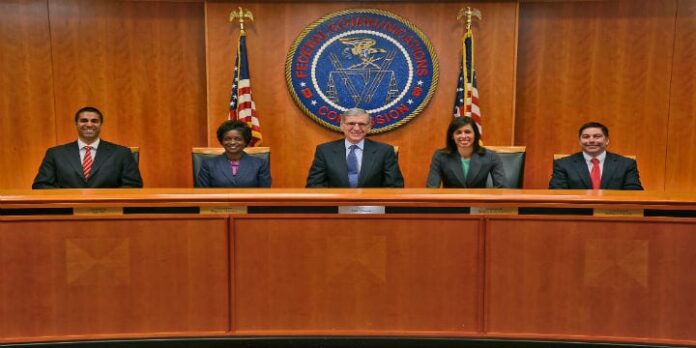FCC set for ‘Spectrum Frontiers’ proceedings next month in move to bolster spectrum support for 5G, IoT and virtual reality
Federal Communications Commission Chairman Tom Wheeler talked all the usual use cases for “5G” technology, including the “internet of things” and virtual reality, in announcing the government agency’s plan to circulate a petition among FCC members stipulating new rules to free up wireless spectrum support.
Wheeler, speaking this week at the National Press Club, anointed the planned circulations as the “Spectrum Frontiers” proceedings, with plans for a vote set for July 14. The proposal will look at solidifying spectrum support across low-, mid- and high-spectrum bands targeting 5G-based services like some use cases called for by IoT applications and virtual reality, which Wheeler cited as “why American leadership in 5G must be a national priority.”
“The driving force of the 21st century will be powerful processing centralized in the cloud and wirelessly connected to thin clients,” Wheeler said. “Autonomous vehicles will be controlled in the cloud. Smart-city energy grids, transportation networks and water systems will be controlled in the cloud. Immersive education and entertainment will come from the cloud. Such futures, however, won’t come to pass unless the pathway to the cloud is low-latency, ultra-fast and secure.”
In terms of low-band spectrum, Wheeler cited the ongoing 600 MHz incentive auction process in which the FCC is looking to free up as much as 126 megahertz of spectrum for use by commercial wireless providers. While not specifically targeted at 5G technologies, many industry observers have said the timeframe in which that spectrum will be made available should see it used as the base layer for those next-generation networks.
As for mid-band spectrum, which Wheeler likened to the “Jan Brady of the spectrum world,” the FCC chairman cited the recent AWS-3 spectrum auction of licenses in the 1.7/2.1 GHz band and work done in the 3.5 GHz band as successes in opening up new support. The AWS-3 spectrum licenses, which generated more than $40 billion for the government treasury, and the so-called Citizens Broadband Radio service spectrum in the 3.5 GHz band, are expected to begin seeing commercial deployments over the next 12 to 18 months.
The upcoming FCC meeting is set to focus on high-band spectrum support, which Wheeler said offers “huge swaths of spectrum for super-fast data rates with low latency, and are now becoming unlocked because of technological advances in computing and antennas.”
The reliance on higher-frequency bands is set to take advantage of small cells, which will be needed in order to ensure coverage and capacity for those bands due to their limited propagation characteristics. Wheeler noted advances in antenna technologies designed to boost signals as core to small cell deployments.
Some spectrum could come from the satellite communications industry, with Wheeler citing previous comments that the satellite and terrestrial stakeholders move on coexistence and sharing options in the 28 GHz band in order to bring more resources to the market. Wheeler also noted some of those assets are currently being used by federal users, which could also be tapped for potential sharing opportunities.
“Unlike some countries, we do not believe we should spend the next couple of years studying what 5G should be, how it should operate and how to allocate spectrum, based on those assumptions,” Wheeler said. “Turning innovators loose is far preferable to expecting committees and regulators to define the future. We won’t wait for the standards to be first developed in the sometimes arduous standards-setting process or in a government-led activity. Instead, we will make ample spectrum available and then rely on a private sector-led process for producing technical standards best suited for those frequencies and use cases.”
Wheeler noted work already announced by the likes of Verizon Communications and AT&T in terms of 5G deployment trials set for 2017, though smaller rivals T-Mobile US and Sprint also have touted their own progress with new network technologies beginning this year.
Wheeler explained the FCC is looking to create larger spectrum blocks of at least 200 megahertz in size in order to support higher speeds. Current spectrum blocks set aside for commercial services are typically around 10 megahertz.
Unlicensed spectrum also is being accounted for in the upcoming meeting, with Wheeler stating plans to free up a 14 gigahertz unlicensed band using flexible-use rules that sounds similar to what the FCC has done in the 3.5 GHz band.
In terms of backhaul support, Wheeler touted the FCC’s Business Data Services proceedings, in which the commission is looking to ensure broader access to wired backhaul assets for wireless networks, and that by year end the FCC plans to take up access reform “that will encourage innovation and investment in Business Data Services while ensuring that lack of competition in some places cannot be used to hold 5G hostage.”
Wheeler also touched on the continuing need for cybersecurity measures tied to 5G deployments, noting his preference that the industry itself work on developing standards similar to what has been done with wired broadband connections.
“If the commission approves my proposal next month, the United States will be the first country in the world to open up high-band spectrum for 5G networks and applications,” Wheeler said. “And that’s damn important because it means U.S. companies will be first out of the gate. We will be repeating the proven formula that made the United States the world leader in 4G. It’s a simple formula: Lead the world in spectrum availability, encourage and protect innovation-driving competition and stay out of the way of technological development.”
Bored? Why not follow me on Twitter

